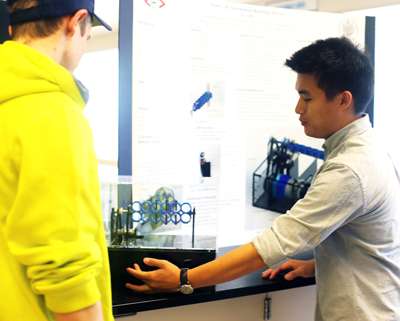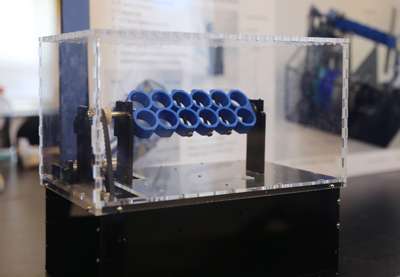Engineers develop clock-inspired, electronics-free device to transport stem cells on planes

(Phys.org) —A group of mechanical engineering students are developing a device to transport stem cells on airplanes—an important problem for the research and biomedical community. The challenge with transporting live cells for stem cell therapies on a plane is twofold. The cells need to be constantly agitated so that they don't clump together and lose their medical properties. And the FAA doesn't allow packages with running electronics on airplanes— so a standard device driven by motors is not an option for transport.
The student project is part of the senior design capstone class for students in the Department of Mechanical and Aerospace Engineering at UC San Diego. The project was sponsored by Dr. Jeffrey Goldberg, professor and director of research at the UC San Diego Shiley Eye Center and his colleague Dr. Noelia Kunzevitzky. Goldberg and Kunzevitzky are working to patent the device and commercialize it for research groups around the world.
"This device has the potential to revolutionize the cell therapy industry," Kunzevitzky said. "The ability to ship stem cells will allow production to enter into a mass production phase rather than a local laboratory setting. This could then drive down prices for cell therapies, making them more readily available for treatment of diseases such as glaucoma and macular degeneration, for example."
In the design capstone class, known as MAE 156b, students work in teams on a wide variety of projects. This year, projects included a system to load a specimen into an MRI, which had to be designed without magnetic materials; a system to reposition 2,500 lb computer servers; and a virtual reality environment for fruit flies, among many others.
The class requires students to work in teams on a project sponsored by a company or faculty member. They have 15 weeks to deliver a working prototype to their sponsors. Along the way, they learn how to apply the theories they learned in their mechanical engineering classes; how to work as part of a team; and how to deliver a working prototype.
"I am so impressed by the student motivation to solving real world problems, along with their creativity and ability to overcome obstacles," said Nathan Delson, a teaching professor who coordinates the capstone design course, which is taught by several instructors.
Working with their sponsors and with their instructor, Jerry Tustaniwskyj, the student team built a device inspired by a mechanical clock, which is spring-driven device and can house and agitate tubes of stem cells during shipping without use of electronics. The device is powered by a series of constant torque springs. Each spring can drive the device for a little more than 12 hours. The device can be modified to house as many springs as needed. The springs drive a gearbox that in turn rotates the vials where the stem cells are stored via a timing belt. The device rotates eight times per minute. Interestingly, the students were inspired by the design of a pendulum clock and escapement mechanism, which they studied in their freshman design class.
The students developed a working prototype, but some fine tuning remains to reduce system friction.

Students on the team said they learned about teamwork and design. "The whole design process was a learning process," said Peter Dvorak, also a mechanical engineering major and June 2014 graduate.
"It's what you do in the real world," said Stephen Chun, a senior and mechanical engineering major who graduated this month.
More information: Details of the project can be seen at: sites.google.com/a/eng.ucsd.ed … 4-spring-team15/home
Provided by University of California - San Diego




















